The war remains in real life, and like IRL, death and destruction continues with Russians attempting to “regroup” in the face of an agile attacking force. Russia has responded with infrastructure attacks with missiles. “Bardak (бардак) means "a mess" in Russian.”
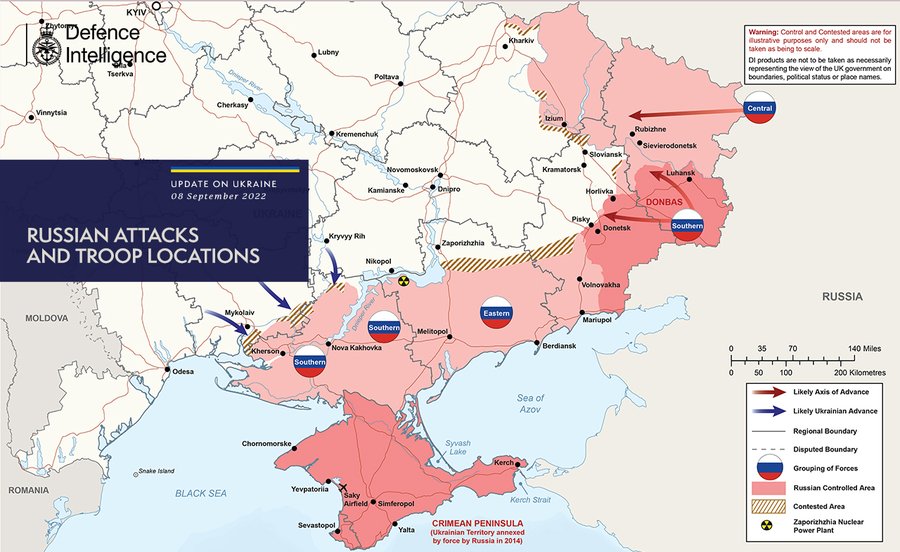
Russia targeted infrastructure facilities in central and eastern Ukraine on Sunday evening in a response to a dramatic Ukrainian counter-offensive in Kharkiv province that has reshaped the war and left Moscow reeling.
The mayor of Kharkiv city, Ihor Terekhov, said a strike had knocked out power and water to much of the city, in what he described as an act of “revenge” by Russia for Ukraine’s recent battlefield successes. There were reports of blackouts in Dnipro, Poltava and other eastern cities, potentially affecting millions of civilians.
[...]
The Ukrainians have retaken the rail hub of Kupiansk, 60 miles east of Kharkiv, and are in the process of seizing Izium, which was being abruptly abandoned by the Russians whose defence ministry said their forces were regrouping.
Then on Sunday night, the country’s military said it had seized checkpoints due north of Kharkiv city, on the Russian border, in an area separate from the breakthroughs of the past week, south-east and east of the industrial city.
In an attempt to hit back, Russia launched strikes targeting the power grid on Sunday that plunged Kharkiv and other areas into darkness. Ukraine’s leadership has long feared that attacks on the grid could take place in the run-up to winter.
www.theguardian.com/...
 www.iswresearch.org
www.iswresearch.org
Ukrainian forces have inflicted a major operational defeat on Russia, recapturing almost all Kharkiv Oblast in a rapid counter-offensive. The Ukrainian success resulted from skillful campaign design and execution that included efforts to maximize the impact of Western weapons systems such as HIMARS. Kyiv’s long discussion and then an announcement of a counter-offensive operation aimed at Kherson Oblast drew substantial Russian troops away from the sectors on which Ukrainian forces have conducted decisive attacks in the past several days. Ukraine’s armed forces employed HIMARS and other Western systems to attack Russian ground lines of communication (GLOCs) in Kharkiv and Kherson Oblasts, setting conditions for the success of this operation. Ukrainian leaders discussed the strikes in the south much more ostentatiously, however, successfully confusing the Russians about their intentions in Kharkiv Oblast. Western weapons systems were necessary but not sufficient to secure success for Ukraine. The Ukrainian employment of those systems in a well-designed and well-executed campaign has generated the remarkable success of the counter-offensive operations in Kharkiv Oblast.
The Ukrainian recapture of Izyum ended the prospect that Russia could accomplish its stated objectives in Donetsk Oblast. After retreating from Kyiv in early April, the stated Russian objectives had been to seize the complete territory of Luhansk and Donetsk Oblasts.[1] The Russian campaign to achieve these objectives was an attack along an arc from Izyum through Severodonetsk to the area near Donetsk City. That attack aimed to seize Severodonetsk, Lysychansk, Slovyansk, Bakhmut, and Kramatorsk, and continue to the western boundary of Donetsk Oblast. Russian forces managed to take Severodonetsk on June 24 and Lysychansk on July 3 after a long and extremely costly campaign but then largely culminated, seizing no major settlements and little territory.[2] The Russian position around Izyum still threatened Ukrainian defenders of Slovyansk, however, and retained for the Russians the opportunity to return to the attack on the northern sectors of the arc, which they had largely abandoned by the middle of July in favor of a focus on Siversk (near Lysychansk) and Bakhmut.
The loss of Izyum dooms the initial Russian campaign plan for this phase of the war and ensures that Russian advances toward Bakhmut or around Donetsk City cannot be decisive (if they occur at all). Even the Russian seizure of Bakhmut, which is unlikely to occur considering Russian forces have impaled themselves on tiny surrounding settlements for weeks, would no longer support any larger effort to accomplish the original objectives of this phase of the campaign since it would not be supported by an advance from Izyum in the north. The continued Russian offensive operations against Bakhmut and around Donetsk City have thus lost any real operational significance for Moscow and merely waste some of the extremely limited effective combat power Russia retains.
There is no basis for assessing that the counter-offensive announced in Kherson Oblast is merely a feint, however. Ukrainian forces have reportedly attacked and made gains at several important locations on the western bank of the Dnipro River. They have cut the two bridges across the river and continue to keep them cut as well as interfere with Russian efforts to maintain supply via barge and pontoon ferry. Ukraine has committed considerable combat power and focused a significant portion of the Western-supplied long-range precision systems it has to this axis, and it is not likely to have done so merely to draw Russian forces to the area.
The Ukrainian pressure in Kherson combined with the rapid counter-offensive in Kharkiv presents the Russians with a terrible dilemma of time and space. Russia likely lacks sufficient reserve forces to complete the formation of a new defensive line along the Oskil River, as it is reportedly trying to do before Ukrainian forces continue their advance through that position if they so choose. Prudence would demand that Russia pull forces from other sectors of the battlespace to establish defensive lines further east than the Oskil River to ensure that it can hold the Luhansk Oblast border or a line as close to that border as possible. But Russian troops around Bakhmut and near Donetsk City continue offensive operations as if unaware of the danger to Luhansk, and Russian forces in Kherson still face attack and the threat of more attacks on that axis. Russian President Vladimir Putin risks making a common but deadly mistake by waiting too long to order reinforcements to the Luhansk line, thereby compromising the defense of Kherson or ending offensive operations around Bakhmut and Donetsk City without getting troops into position to defend against continuing Ukrainian attacks in Luhansk in time. The Ukrainian campaign appears intended to present Putin with precisely such a dilemma and to benefit from almost any decision he makes.
The current counter-offensive will not end the war. The campaign in northeast Ukraine will eventually culminate, allowing the Russians to re-establish a tenable defensive line and possibly even conduct localized counterattacks. Ukraine will have to launch subsequent counter-offensive operations, likely several, to finish the liberation of Russian-occupied territory. The war remains likely to stretch into 2023.
Ukraine has turned the tide of this war in its favor. Kyiv will likely increasingly dictate the location and nature of the major fighting, and Russia will find itself increasingly responding inadequately to growing Ukrainian physical and psychological pressure in successive military campaigns unless Moscow finds some way to regain the initiative.
Russian officials and milbloggers involved with the Russian war in Ukraine are increasingly blaming the Russian Ministry of Defense (MoD) for Russian failures on the frontlines. Chechen leader Ramzan Kadyrov stated that if there are no changes to the Russian “special military operation” today or tomorrow, then he will contact the Kremlin to “explain the situation on the ground.”[3] Kadyrov’s statement is a thinly veiled criticism of the Russian MoD for its lack of situational awareness (or honesty) and highlights the MoD’s preoccupation with maintaining the façade of a successful and swift Russian invasion of Ukraine. The Russian MoD has not acknowledged the successful Ukrainian counteroffensive operations around Kharkiv Oblast, instead promulgating a clearly false narrative of a deliberate Russian repositioning without any meaningful justification. A milblogger also noted that a civilian such as the head of the Wagner Group private military company Yevgeniy Prigozhin should replace Russian Defense Minister Sergey Shoigu because civilians can better handle the harmful nature of the military bureaucracy.[4] The intensifying public attacks on Shoigu and the Russian MoD shield Russian President Vladimir Putin from the responsibility for setting unattainable goals for the invasion and likely micromanaging military operations by pinning all the blame for Russian failures on the MoD and higher military command. Putin may accept and even support these attacks to continue this diversion of blame from him.
The Kharkiv Oblast counter-offensive is already damaging the Kremlin’s relationship with the Russian MoD, further alienating Putin from the higher military command. Kremlin Spokesperson Dmitry Peskov stated that Putin has postponed all his meetings with the leadership of the Russian MoD and representatives of the Russian defense industry in Sochi—a bizarre decision in the face of the military operational and defense industrial crisis facing Russia.[5]
The Russian defeat in the Battle of Kharkiv Oblast will only intensify public criticism of Shoigu and the MoD, which may lead to personnel changes. The Ukrainian Main Military Intelligence Directorate (GUR) reported that the western grouping of forces has been placed under the command of the Commander of the Central Military District Colonel General Alexander Lapin who is currently commanding the central group of forces in Ukraine.[6] The GUR added that the Kremlin is looking for a replacement for the commander of the western grouping of forces Lieutenant General Roman Berdnikov, who had just replaced Lieutenant General Andrey Sychevoy on August 26.
Ukrainian authorities shut down the last active reactor at the Zaporizhzhia Nuclear Power Plant (ZNPP) on September 11. Ukrainian nuclear energy agency Energoatom announced that it began to prepare nuclear reactor no. 6 for a cold shutdown after Energoatom restored a backup powerline connecting the ZNPP to the Ukrainian power grid on September 11.[7] Energoatom stated that the reactor had been producing energy at 10-15% of its capability, the bare minimum necessary to sustain ZNPP operations.[8] Energoatom stated that a cold shutdown is the safest state for the ZNPP as frequent Russian shelling continues to damage power lines necessary to operate the plant safely.[9] The Russian Ministry of Defense (MoD) claimed that Ukrainian forces shell the ZNPP as part of a broader campaign against energy infrastructure in occupied territories and Russian milbloggers amplified this narrative.[10] Energoatom and the International Atomic Energy Agency reiterated that shelling the ZNPP must end and that Russian authorities must demilitarize and declare a safe zone around the ZNPP.[11]
Russian forces conducted a wave of precision strikes against Ukrainian energy infrastructure on September 11 causing widespread power outages.[12] The attacks are likely meant to let Moscow claim that it is launching a new phase of offensive operations even as it loses on the ground, and possibly also to punish Ukraine for shutting down the ZNPP despite Russia’s desire to keep it operating.
www.iswresearch.org
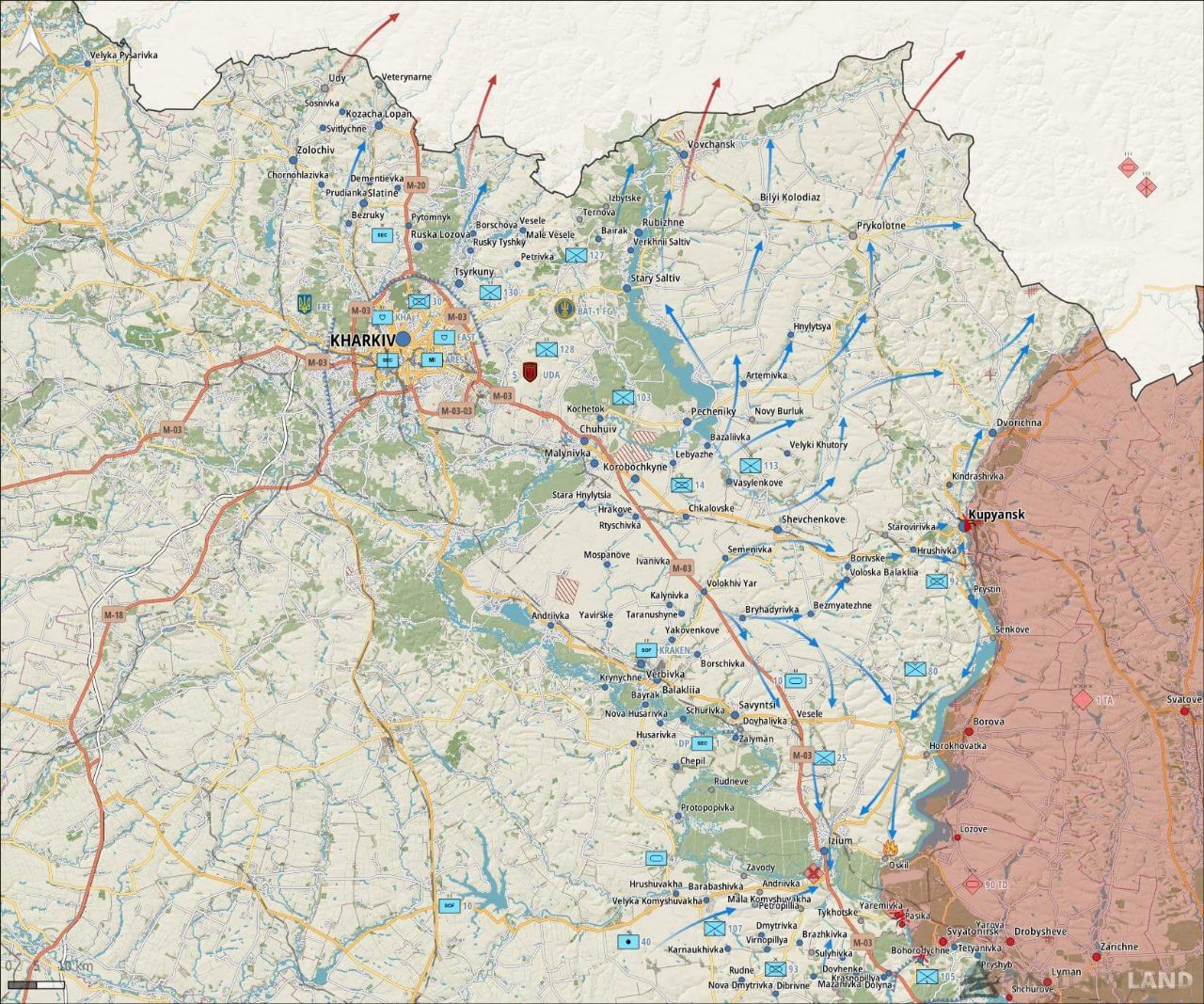
Key Takeaways
- Ukrainian forces have inflicted a major operational defeat on Russia, recapturing almost all Kharkiv Oblast in a rapid counter-offensive
- Ukrainian authorities shut down the last active reactor at the Zaporizhzhia Nuclear Power Plant on September 11.
- The Russian Ministry of Defense confirmed that Russian forces are withdrawing from positions throughout all but easternmost Kharkiv Oblast.
- Russian milbloggers have defined the Oskil River that runs from Kupyansk to Izyum as the new frontline following Russian withdrawal from positions in eastern Kharkiv Oblast.
- Ukrainian forces have advanced into Vovchansk and Velykyi Burluk, just south of the international border.
- Ukrainian forces continue to fight positional battles and conduct strikes on Russian military, logistics, and transportation assets along the Southern Axis.
- Russian forces conducted limited ground attacks in the Avdiivka and Bakhmut areas.
- Russian authorities are continuing to pull combat power from various external sources to support operations in Ukraine and are struggling to compensate volunteers.
- The success of recent Ukrainian counteroffensives likely contributed to the Russian announcement that annexation referenda will be indefinitely postponed.
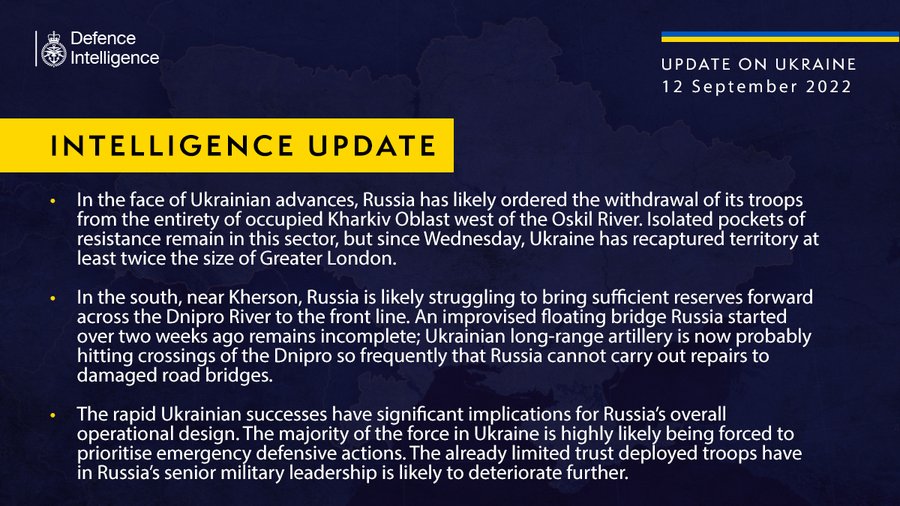
Eastern Ukraine: (Vovchansk-Kupyansk-Izyum-Lyman Line)
The Russian Ministry of Defense’s September 11 briefing map confirmed that Russian forces are withdrawing from settlements around Kharkiv City, from northern Kharkiv Oblast, and settlements on the western bank of the Oskil River.[13] Russian sources and milbloggers have identified the Oskil River that flows through Kupyansk and Izyum as the new front line on the axis, and Russian forces are likely also continuing to operate on the eastern bank of the Siverskyi Donets River southeast of Izyum.[14] Geolocated and social media footage confirmed that Ukrainian forces have entered Vovchansk and Velykyi Burluk severing Russian ground lines of communication (GLOCs) along the T2104 highway and have reached the international border north of Kharkiv City.[15] Geolocated footage also shows that Ukrainian forces took control of Izyum and settlements south and southwest on September 11.[16] Russian troops likely withdrew from the area in great haste, and social media posts show abandoned tanks and other heavy military equipment near Izyum, which indicates that Russian troops failed to organize a coherent retreat.[17] Russian sources claimed that Ukrainian troops are continuing efforts to cross the Siverskyi Donets River northeast of Slovyansk and enter Lyman. A Russian milblogger indicated that Russian troops are targeting Ukrainians around Lyman, but that Russian troops retain control of the settlement despite attempted Ukrainian advances.[18] Combat footage taken in Bilohorivka, Luhansk Oblast, on September 11 confirms that Ukrainian troops have retaken ground in Luhansk Oblast. The Ukrainian soldiers in the footage appear to be hiding from artillery strikes, which indicates that Russian troops are now targeting positions in Bilohorivka.[19]
www.iswresearch.org
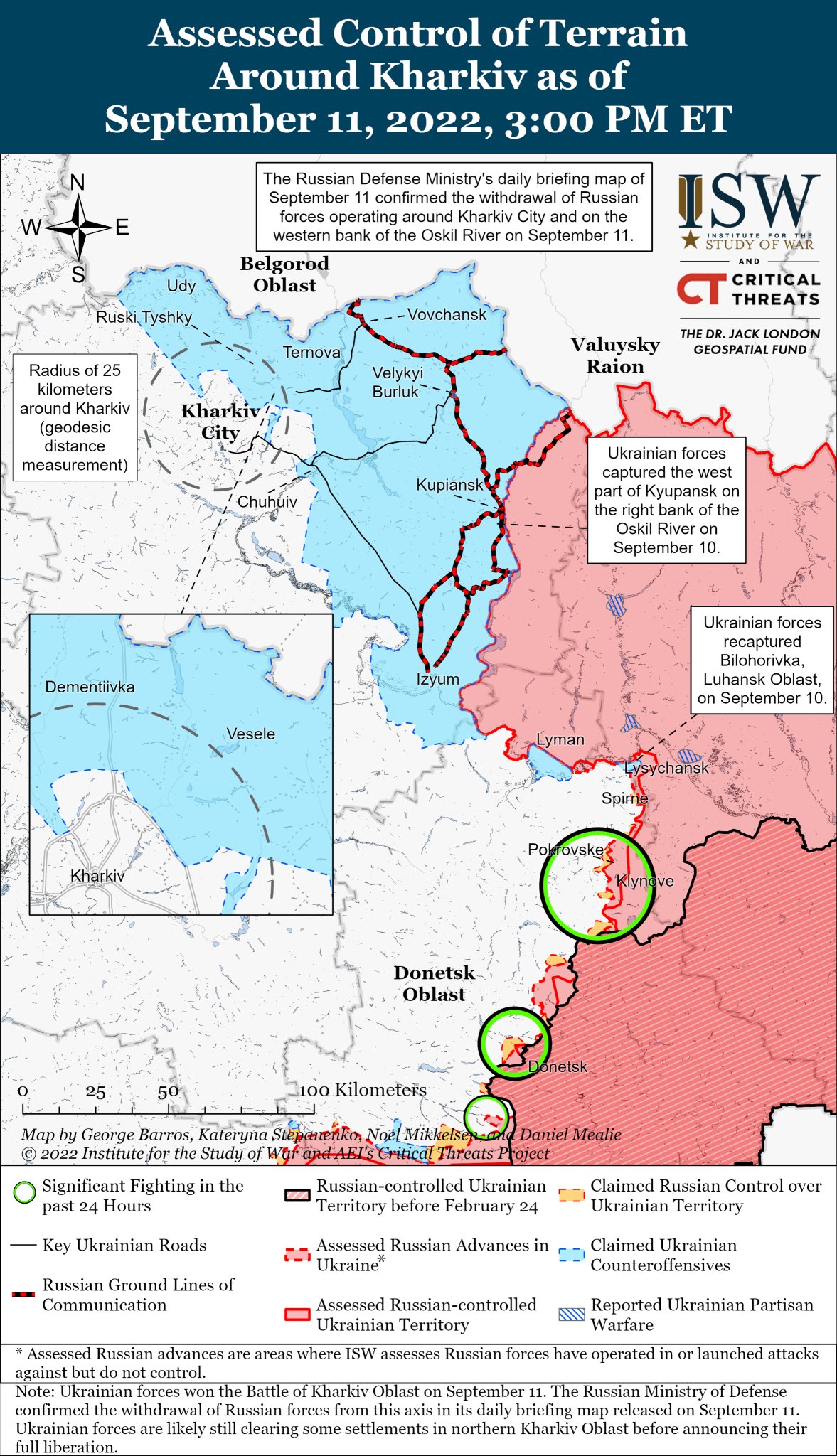 www.iswresearch.org
www.iswresearch.org
 www.iswresearch.org
www.iswresearch.org
Southern Ukraine: (Kherson Oblast)
Granular tactical and operational-level visibility on the progress of the Ukrainian counteroffensive in Kherson Oblast has been degraded over the last few days as the focus of coverage has shifted to the Ukrainian counteroffensive in Kharkiv Oblast. This shift in the information space is not likely reflective of a pause in Ukrainian operations in the south, and Ukrainian troops are likely to continue counter-offensive operations in Kherson Oblast based on the limited reporting that is available.
Ukrainian military officials stated that Ukrainian forces continued positional battles and strikes on Russian transportation, logistics, and military assets throughout the Southern Axis on September 11. Ukraine’s Southern Operational Command reiterated that Ukrainian troops are engaged in positional battles in unspecified areas along the Kherson-Mykolaiv frontline and carried out over 130 fire missions over the day.[20] The Ukrainian General Staff stated that Ukrainian troops have carried out over 28 major strikes and hit approximately 19 concentrations of Russian manpower and military equipment within the last 24 hours.[21] Ukrainian military officials indicated that Ukrainian troops focused on hitting Russian bridges and alternative river crossings to disrupt Russian transportation capabilities across the Dnipro River.[22]
www.iswresearch.org
 www.iswresearch.org
www.iswresearch.org

"The (RAND Corporation and the Friedrich Ebert Foundation) document they produced suggests there could be just enough common ground to escape the cycle of conflict."

Yet, "As Moscow first demonstrated by invading Georgia in 2008, what it cannot achieve through persuasion, it is prepared to impose with force."
LOL also bronze solider incident in Estonia was 2007 but never let "realism" impede facts.

On think-tank solutions no one but a paper's authors are convinced are "real": "Finally, our plan would provide mechanisms and processes to immediately improve the livelihoods of people living in regional conflict zones and eventually progress toward mutually agreed settlements."

On the "realism" that this is about NATO expansion not neocolonialism, death cultism: "In return for voluntarily adopting a nonaligned status, Kyiv could receive both multilateral security guarantees and Russian commitments of military restraint, including along the border area."

More "realism" from this graf: "Russia and the West would hold regular consultations on security issues and, importantly, commit to seeking mutual consensus before making changes to the regional security architecture. They would commit to respecting Ukraine’s nonalignment."
More "realism" in this graf: "And in addition to its current free trade deal with the EU, Ukraine would benefit from a restoration of trade with Russia (now hampered by Moscow’s punitive sanctions) and the creation of a trilateral consultation mechanism with the EU and the EAEU."
Guys listen to the "realists" who are not appeasers but nice people with nice ideas: "Many consider seeking mutual agreement on a stable regional order to be tantamount to appeasement. This view has the effect of stifling debate and shutting down discussions of alternatives."

Missiles love robust debate!
Good people, on both sides: "Still, we encountered many—both inside and outside government—who recognized that the status quo serves no one and were willing to consider alternatives like ours."

The conclusion: "Our proposal shows that such consensus might yet be possible."
To those "realists" who will object, but this was not tried! Aha, welcome to "realism"!
What fun, if you want a really rancid vintage.
If you loved this, you will love the follow up work of "realism":

The real problem with Charap's "realism" when it comes to Ukraine? He never properly debated a Russian missile before and the Russian missiles never had the chance to fully absorb the mastery of his "realist" takes, or maybe they did and were like, nah.
• • •
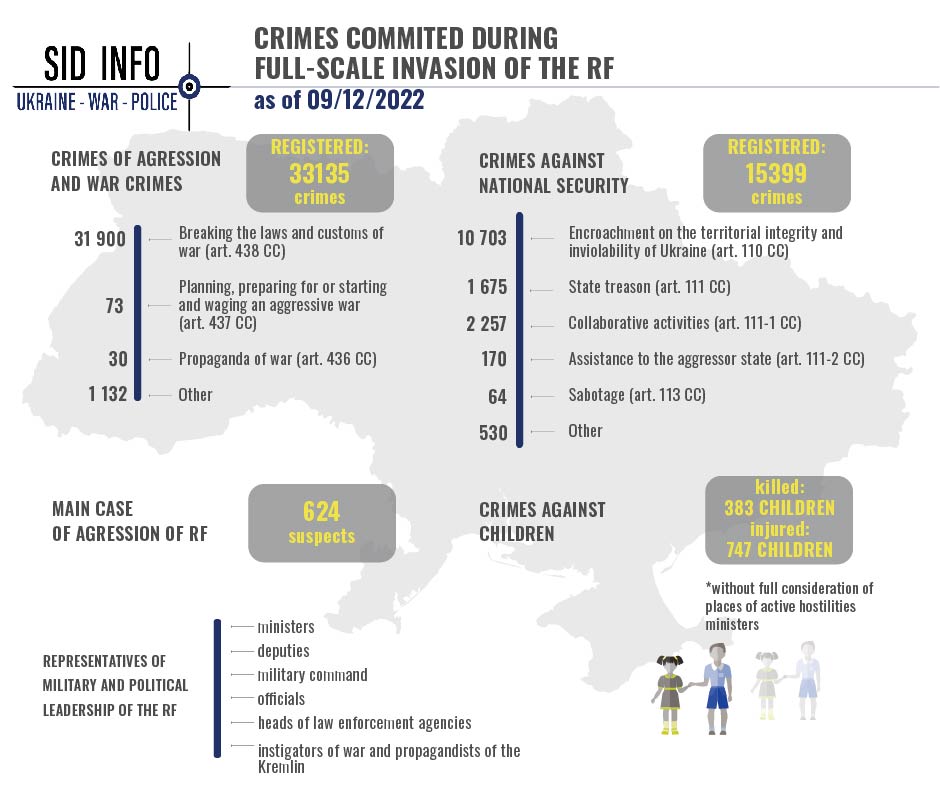
»Der Kapitalismus ist kannibalistisch«


